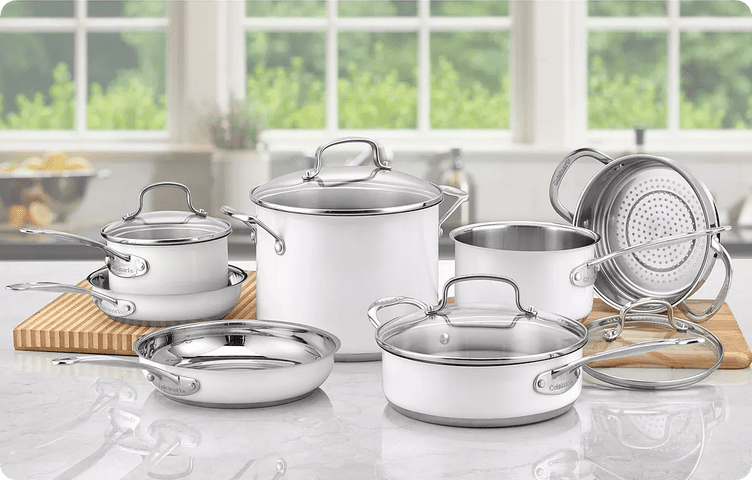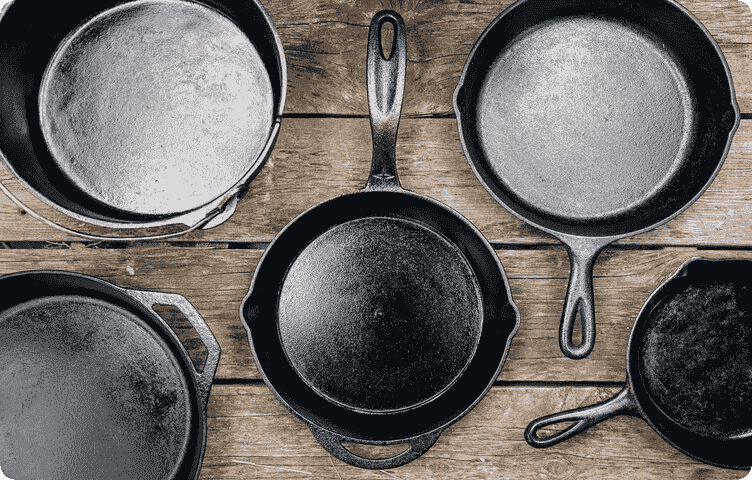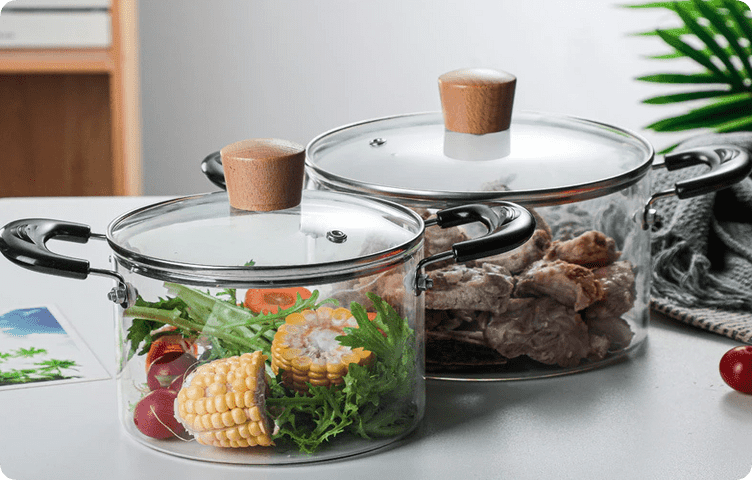Induction cooking is considered energy efficient, safe and environmentally friendly. Instead of fire, the new stoves use electromagnetic energy. But not all types of cookware are compatible with this technology. Incorrectly selected pans and pots can damage your equipment. Before you go to the store, get to know the features of unusual utensils.
What is the difference between tableware for individual entrepreneurs?
Electromagnetic induction allows you to cook without fire, therefore eliminating the risk of burns and fires. New cooking technology provides more precise temperature settings, which is important for control over cooking. There is a copper coil under each cooking zone of the induction hob. When the electricity is turned on, it turns into a magnet, heating the bottom of the pan directly. Induction automatically adjusts to the size of the utensil. The temperature of the panel does not change, so it can be washed immediately after cooking.

Pots , saucepans and frying pans for induction cookers must be made of materials with ferromagnetic properties. Among them:
- cast iron;
- stainless steel;
- carbon steel;
- enameled metal.
The packaging of such products is usually marked with an image of a spiral or the induction inscription. A good option is considered to be products with a flat and thick bottom, corresponding to the size of the burner - at least 20 cm in diameter. A slightly larger diameter is allowed, but such a vessel will heat up more slowly.
During operation of the induction cooker, slight vibrations occur. Therefore, pots and pans should be heavy, with tight-fitting lids. Securely attached handles also reduce the risk of noise.
What cookware is not suitable for an induction cooker?
Many materials do not interact with electromagnetic energy. Non-ferrous metals, glass, and ceramics do not contain iron, so they do not heat up due to induction. Stainless steel will also be useless if it is made of nickel.
Sometimes aluminum, copper and ceramic products are supplemented with iron plates. But if their size does not match the diameter of the burners, the pots and pans will not work on the IP.
You can check compatibility with a piece of a regular magnet. It is attracted to the base of the product - which means it is suitable for the induction panel.
The shape of the vessel also plays an important role. A convex bottom, like a wok, heats up slowly and unevenly, which impairs the cooking process.
Types by materials
If you bought an induction cooker, this does not mean that you will have to completely change your kitchen utensils. All products that contain a lot of iron can be successfully used on new equipment.
Stainless steel pans

Stainless steel interacts well with magnetic induction. But this material is considered conditionally compatible, since some of its varieties are produced with a low iron content.
Three more features of stainless steel need to be taken into account:
- products with non-ferrous metal cores between layers of steel conduct heat better than all-steel ones. The heat is distributed most evenly in a five-layer structure;
- an aluminum disk built into the bottom effectively distributes thermal energy throughout the entire container;
- The price of stainless steel pots and pans is quite high, but such products last for many years.
The best models of steel cookware for individual entrepreneurs are produced by Taller, Tefal, and Neva Metal.
Cast iron

Since cast iron is made from ferrous metals, it is an ideal conductor of electromagnetic energy. Cast iron cookware is heavy enough to sit firmly on the burner. When used correctly, it acquires non-stick properties. But such a frying pan should not be heated too much, otherwise it may crack right on the stove during cooking. To avoid this, heat the pan slowly and add food to it as soon as the oil inside boils.
Another disadvantage of cast iron is its rough bottom, which can scratch the glass hob.. It is important to choose utensils with the smoothest possible surface. When moving the pan from one burner to another, it is recommended to carefully lift it rather than move it.
The ranking of the best manufacturers of cast iron equipment for induction is headed by Lodge , Le Creuset and Prohote l. They produce frying pans of different sizes, stewpans, and ducklings.
Enameled
Utensils coated with porcelain enamel can be used on an induction hob if the base of the product is made of ferrous metal - steel or cast iron. The outer layer of a material resembling tempered glass in properties does not interfere with magnetic induction. Such products are durable and resistant to temperature changes. They are suitable for stewing, boiling, frying and baking, and are easy to clean by hand and in the dishwasher.
Heating an enamel pan or cauldron takes a little longer than a stainless steel one. But the heat is evenly distributed and retained inside for a long time, even after the stove is turned off.
An important advantage when choosing enamel cookware is its significant weight, which ensures stability. Enamel closes the pores of the metal, protecting food from burning. But if handled carelessly, the coating may break off, after which the product cannot be used for cooking.
The top 10 manufacturers of enamel pans for induction are headed by Appetite and Vitross. Their products are distinguished by durable coating, beautiful design, and ease of care.
Glass, aluminum and copper

Glass and non-ferrous metals do not have magnetic properties, so they are not used on induction cookers. But there are models designed specifically for this equipment, with metal inserts on the bottom. Glass and ceramic products are made from heat-resistant materials. The bottom, 1-2 cm thick, is equipped with a built-in magnetic disk.
Using the same principle, cookware is made from cast aluminum and copper . Its base is a multilayer structure in which plates of ferrous and non-ferrous metals alternate. Thanks to this, pans and pots acquire the ability to conduct electromagnetic energy. They are much more convenient in everyday life than products made of cast iron, as they heat up faster and do not rust.
Induction utensils made of glass, copper, aluminum are lightweight, heat resistant, and easy to clean. It costs less than products made of cast iron and steel. The main thing is to correctly select the diameter of the bottom to the size of the burner.
Is it possible to cook on an induction cooker in regular cookware?
Traditional frying pans do not have the magnetic elements needed to generate heat. IP technology creates an electrical circuit - alternating current is passed into a spiral under the surface of the hob.
This creates a magnetic field around the burner. If you place a vessel on top that has electromagnetic conductivity, the energy begins to heat it up. For regular cookware to work on an induction hob, it must have a flat, smooth bottom and contain a large amount of iron. A warped surface with dents or protrusions will not heat up on an induction hob. Most often, minor damage occurs on non-stick pans.
To check if the product has defects, pour some water into it and place it on the table. If “islands” form in the center, it means that the bottom begins to deform.
Do not rush to part with utensils that do not meet the requirements of induction. Manufacturers offer a good solution - adapter disk . This is a special plate made of black metal that can be placed on top of the hob. When heated, the adapter transfers heat to non-magnetic pots and pans. Cooking food this way takes a little longer, but you won’t have to renew all your utensils.
How to care for induction cookware
Equipment with a metal bottom is easier to clean and maintain than regular equipment. This does not require special tools. Hand wash only, no dishwasher or abrasive powders allowed.
It is recommended to use only traditional means, including:
- white vinegar;
- baking soda;
- lemon juice;
- dishwashing liquid.
Effective cleaner for heavily soiled dishesIt is prepared from 0.5 cups of coarse sea salt, 2 tablespoons of white vinegar, 1 tablespoon of dishwashing liquid and 0.5 cups of warm water. This mixture dissolves stubborn fat and carbon deposits and gives the metal a beautiful shine. Compositions with acids and salt are suitable for cleaning cast iron and steel. Products made of non-ferrous metals can only be washed with mild soap.
Old dishes that are difficult to clean from sticky grease can be cleaned with toothpaste. A small amount of this product is applied to the surface of a frying pan or saucepan and rubbed with a sponge. The paste removes old fat in the same way as plaque.
It is recommended to soak heavily soiled pans and pots with hot water and baking soda or soap for 30-40 minutes. They are then washed with a sponge and rinsed with clean water.
It is necessary to regularly check whether rust has appeared on the induction cookware. If you notice signs of corrosion, wash the stains with soap and water, and then dry the product thoroughly with a soft cloth.
To make the product last longer, do not use metal utensils while cooking. They leave scratches that gradually destroy the surface. Also avoid harsh washcloths and aggressive detergents.
















































/https%3A%2F%2Fcomplexbar.com%2Fimages%2Fblog%2F133%2Fd1525d119076075.6095ca6a5ceff.jpg)
/https%3A%2F%2Fcomplexbar.com%2Fimages%2Fblog%2F246%2Fsirop_scale_2400.jpeg)
/https%3A%2F%2Fcomplexbar.com%2Fimages%2Fblog%2F246%2Fkofe-vostochniy.jpg)
/https%3A%2F%2Fcomplexbar.com%2Fimages%2Fblog%2F245%2Fpexels-jason-villanueva-851555.jpg)
/https%3A%2F%2Fcomplexbar.com%2Fimages%2Fblog%2F246%2F2024-04-09_17.22.54.jpg)
/https%3A%2F%2Fcomplexbar.com%2Fimages%2Fblog%2F246%2F2024-04-09_17.22.47.jpg)
/https%3A%2F%2Fcomplexbar.com%2Fimages%2Fblog%2F246%2FCODE_anons_foamydrops_752%D1%85480_eng.jpg)
/https%3A%2F%2Fcomplexbar.com%2Fimages%2Fblog%2F246%2FAlina_752%D1%85480_eng.jpg)
/https%3A%2F%2Fcomplexbar.com%2Fimages%2Fblog%2F246%2F2024-04-09_17.23.22.jpg)
/https%3A%2F%2Fcomplexbar.com%2Fimages%2Fblog%2F246%2F2024-04-09_17.23.28.jpg)
/https%3A%2F%2Fcomplexbar.com%2Fimages%2Fblog%2F246%2F2024-04-09_17.23.35.jpg)
/https%3A%2F%2Fcomplexbar.com%2Fimages%2Fblog%2F246%2Fdrinksome_752%D1%85480_eng.jpg)
/https%3A%2F%2Fcomplexbar.com%2Fimages%2Fblog%2F246%2Fnude_752%D1%85480_eng.jpg)
/https%3A%2F%2Fcomplexbar.com%2Fimages%2Fblog%2F246%2F752%D1%85480_eng__1_.jpg)
/https%3A%2F%2Fcomplexbar.com%2Fimages%2Fblog%2F246%2F752%D1%85480_eng.jpg)
/https%3A%2F%2Fcomplexbar.com%2Fimages%2Fblog%2F246%2FStudioRaw_752%D1%85480_eng.jpg)
/https%3A%2F%2Fcomplexbar.com%2Fimages%2Fblog%2F246%2FDoppio_tea_752%D1%85480_eng.jpg)
/https%3A%2F%2Fcomplexbar.com%2Fimages%2Fblog%2F246%2FTognana_Stars_Stripes_752%D1%85480_eng.jpg)
/https%3A%2F%2Fcomplexbar.com%2Fimages%2Fblog%2F246%2FRona_752%D1%85480_eng.jpg)
/https%3A%2F%2Fcomplexbar.com%2Fimages%2Fblog%2F246%2FDoppio_vending_752%D1%85480_eng.jpg)
/https%3A%2F%2Fcomplexbar.com%2Fimages%2Fblog%2F246%2FEssence_sukhie_smesi_752%D1%85480_eng.jpg)
/https%3A%2F%2Fcomplexbar.com%2Fimages%2Fblog%2F246%2FODK_sukhie_smesi752%D1%85480_eng.jpg)
/https%3A%2F%2Fcomplexbar.com%2Fimages%2Fblog%2F246%2Funiforma-barmena.jpg)
/https%3A%2F%2Fcomplexbar.com%2Fimages%2Fblog%2F246%2Fkak-nanyat-barmena.jpg)
/https%3A%2F%2Fcomplexbar.com%2Fimages%2Fblog%2F246%2Fsirop_scale_2400.jpeg)
/https%3A%2F%2Fcomplexbar.com%2Fimages%2Fblog%2F246%2FPeugeot_Anons_Paris_U%27Select_Line_Daman_752%D1%85480_eng.jpg)
/https%3A%2F%2Fcomplexbar.com%2Fimages%2Fblog%2F246%2Fkofe-vostochniy.jpg)
/https%3A%2F%2Fcomplexbar.com%2Fimages%2Fblog%2F246%2FMadler.jpg)
/https%3A%2F%2Fcomplexbar.com%2Fimages%2Fblog%2F246%2Fprofbartender_glavn.jpeg)